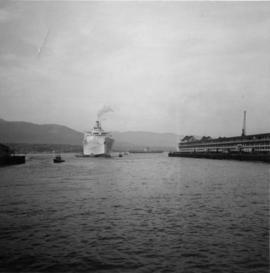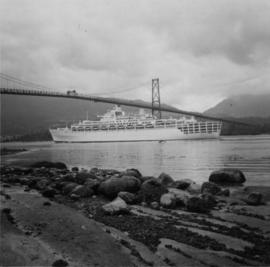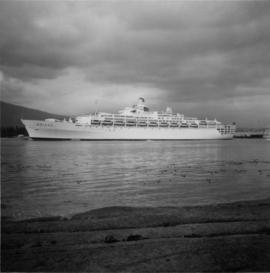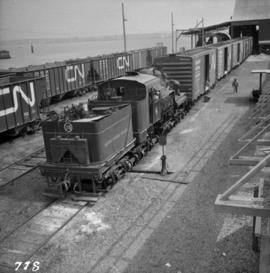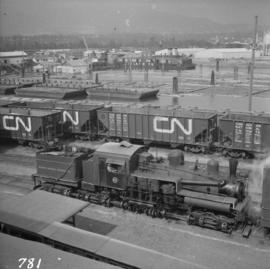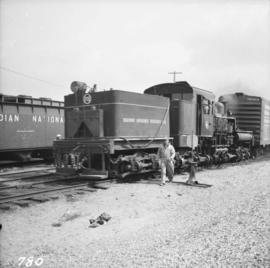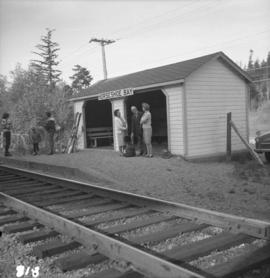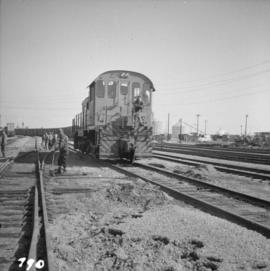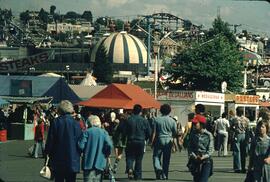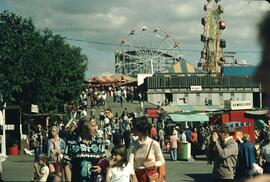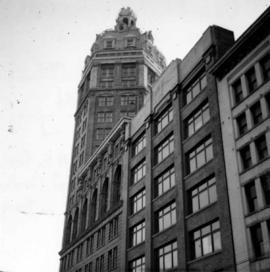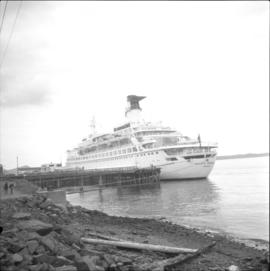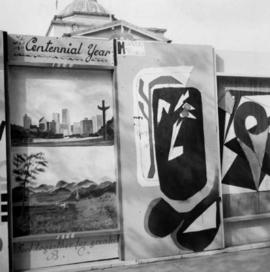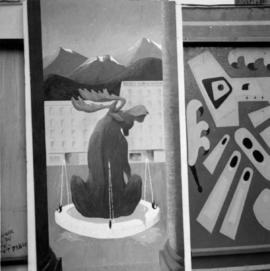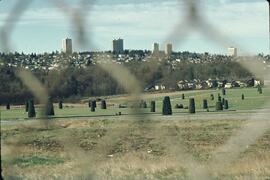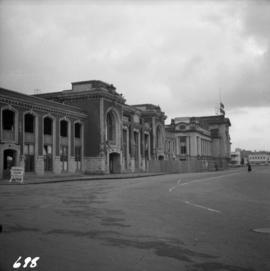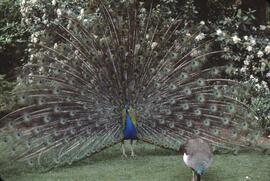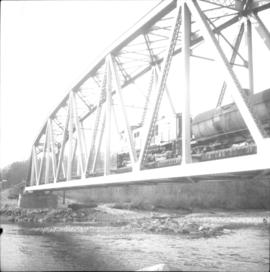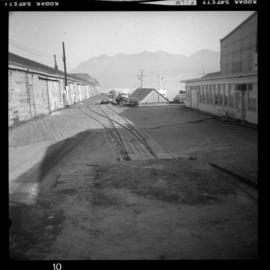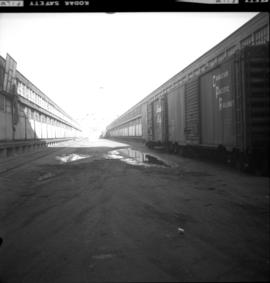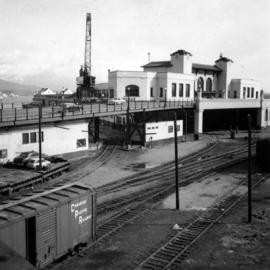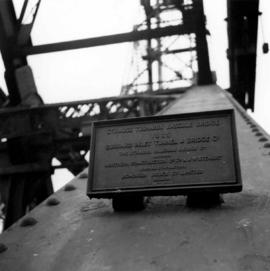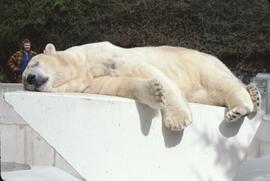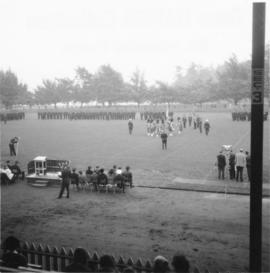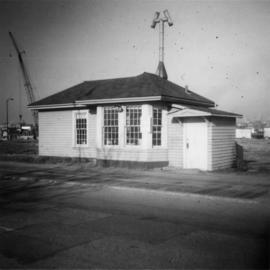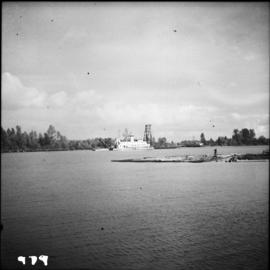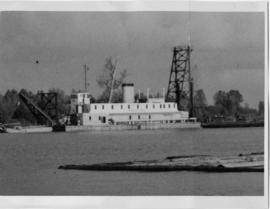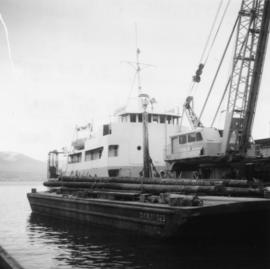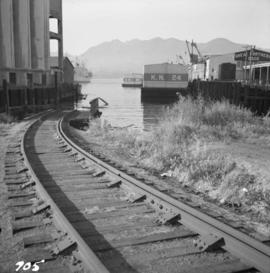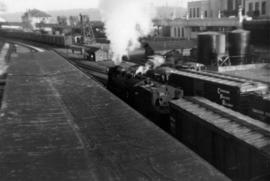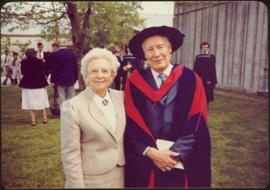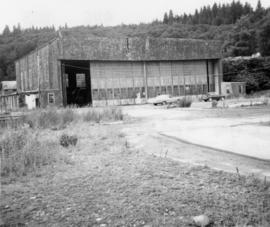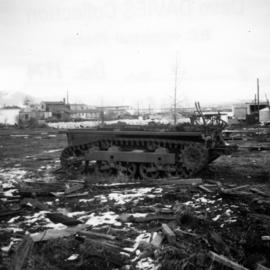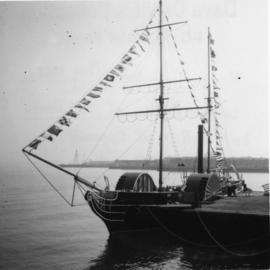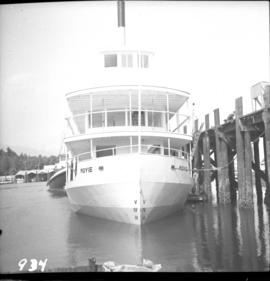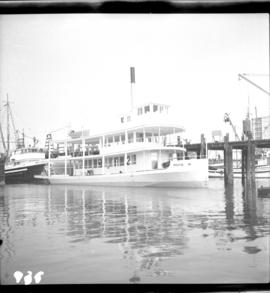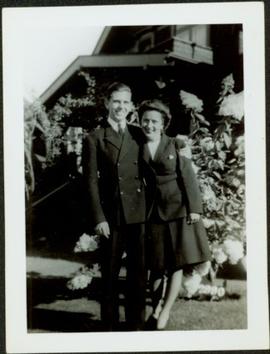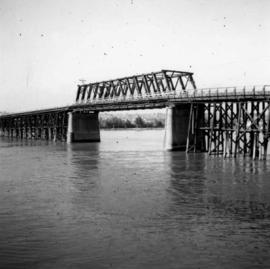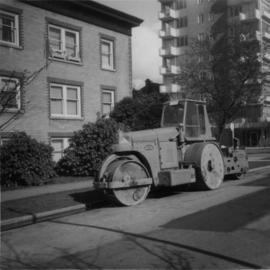Photograph depicts a liner called the "Oriana."
Vancouver, BC
675 Archival description results for Vancouver, BC
Photograph depicts the Orient/P & O line, the "Oriana," that was built in 1960 by Vickes Armstrong. It was turbine driven.
Photograph depicts a P & O liner, the "Oriana,"departing from CPR Pier C.
Photograph depicts a P & O liner, the "Oriana," passing outward bound from Vancouver between Brockton Point and the Lion's Gate Bridge. Taken from Stanley Park.
Photograph depicts a P & O liner, the "Oriana," passing outward bound from Vancouver between Brockton Point and the Lion's Gate Bridge. Taken from Stanley Park.
Photograph depicts Pacific Coast Terminals in North Vancouver. A Shay #1115 is spotting cars carrying potash, sulphur etc. onto the tippler.
Photograph depicts the Pacific Coast Terminals in North Vancouver. A Shay #115 is spotting a string of cars onto tippler.
Photograph depicts the Pacific Coast Bulk Terminals on the North Shore, 1 mile east of Lions Gate Bridge in Vancouver. Previously owned by Hillcrest Lumber #11 and Merrill & Ring #5. In the foreground is 90-ton Shay locomotive #115 from the Railway Appliance Research Ltd. It was built by Lima Locomotive Works in 1929 and is builders #3350. It was last owned by Canadian Forest Products on Nimpkish Valley Railway on North Vancouver Island, up until at least the mid-1960s.
Photograph depicts the Pacific Coast Terminals in North Vancouver. Shay locomotive #115 is in the yards.
Photograph depicts that Pacific Great Eastern depot at Horseshoe Bay, awaiting the dayliner to Quesnel. A two-coach Budd car runs from North Vancouver to Lillooet, and then a different 1-coach Budd car continues to Quesnel. It is possible to do a roundtrip from North Vancouver to Lillooet in one day.
Photograph depicts the Pacific Great Eastern yards at North Vancouver. In the picture is Locomotive #1002 built by the Montreal Locomotive Works.
Photograph depicts the Pacific Press Ltd. Vancouver Sun building at Beatty and West Pender St. The view is looking northeast from Beatty St. It was vacated by the Vancouver Sun at Christmas 1965 with the neon "Sun" sign on the tower removed.
Photograph depicts a liner called the "Pacific Princess." It was built in 1971 in West Germany. The liner was one of the 8-day summer crusises that travelled from Vancouver to Alsaska. Owned by P & O and registered "London."
Drawing of proposed Pacific Rim Stadium on False Creek in Vancouver. The drawing shows details of the baseball configuration, football configuration, and a perspective sketch of the stadium adjacent to the Georgia Viaduct. Annotated sketch of light rail transit route is also depicted.
Photograph depicts a painting on the fence outside a courthouse on Howe and Granville St. In Vancouver, B.C. Each artist was granted a permit and panel by City Council.
Photograph depicts a painting on a fence outside a courthouse on Howe St. in Vancouver, B.C. The painting shows the natural grandeur of B.C. partially blocked out by a super motel with a bewildered moose forced to become an ornamental fountain. The whole forecourt is being bulldozed to make way for the Centennial fountain.
Photograph depicts a partially demolished Great Northern Railway depot and Canadian National Railway (CN) depot behind it, in Vancouver.
Photograph depicts a Pacific Great Eastern bridge over the Capilano River in northwest Vancouver. Also visible is a switching locomotive.
Photograph depicts Pier #2 in Vancouver at the north end of Columbia St. It shows disconnected trackage on the east side of the pier that was formerly serviced by the CPR. It has not been in use for some years. The switch fittings were made by the Nelson Iron Works in Seattle.
Photograph depicts Pier B in Burrard Harbour, Vancouver. The photo shows the inside the main roadway and the CPR trackage.
Photograph depicts Pier B of C.P.R., just west of the C.P.R. railway station. This is the only pier accessible to ocean going passenger liners and is used by P&O vessels. Facilities generally in adequate for the 1960s.
Photograph depicts a plaque attached to the east side girder of bascule section of the Second Narrows railway bridge in Vancouver, BC
Photograph taken at Brockton Oval, Stanley Park in Vancouver. Depiction of the Presentation of 2 Colours to the Vancouver City Police Force by Lieutenant-Governor of B.C. At this point, the colours had just been consecrated on an alter of drums. Drummers were regaining their drums.
Map depicts the proposed electoral districts of British Columbia, including: Burnaby, Capilano, Cariboo-Chilcotin, Comox-Powell River, Cowichan-Malahat-The Islands, Esquimalt-Saanich, Fort Nelson-Peace River, Fraser Valley East, Fraser Valley West, Kamloops-Shuswap, Kootenay East, Kootenay West, Mission-Port Moody, Nanaimo-Alberni, New Westminster-Coquitlam, North Vancouver-Burnaby, Okanagan North, Okanagan-Similkameen, Prince George-Bulkley Valley, Richmond-South Delta, Skeena, Surrey-White Rock-North Delta, Vancouver Centre, Vancouver East, Vancouver Kingsway, Vancouver Quadra, Vancouver South, and Victoria.
Photograph depicts a Public Weigh Scale that was operated in Vancouver, on Main Street, opposite the CN Depot.
Photograph depicts the P.W.D. dredger at work in the north arm of the Fraser River in Vancouver.
Photograph depicts the Public Works Department dredger (suction) at work in the north arm of the Fraser River, near Boundary River, in Vancouver.
Photograph depicts a Public Works Department vessel, "Essington II." It was fitted with a crane and used for snag removing, buoy work and light pile driving. Here, it was shown with the barge alongside it.
Photograph depicts a view looking northeast down a rail and road lane at the west end of Homer St. in Vancouver. It shows CP box car #296105 with end loading doors, built in November 1951. The car was empty. The rail in this area is dated 1911.
Photograph depicts a disused rail barge slip on the south side of Vancouver harbour, just east of Campbell Ave. and leading off the Canadian National Railway (CN) and Great Northern Railway (GNR)trackage coming for the False Creek yards. The view is looking north.
Photograph depicts rail cars in Vancouver, B.C.
Typed on verso of ticket: "CANADIAN NATIONAL RAILWAYS WESTERN REGION" "EMPLOYES TRIP PASS - FIRST CLASS" "SUBJECT TO CONDITIONS ON BACK" "PASS (1) Miss V. B. Taylor, ACCOUNT Stenographer -- C.N.R. TO Vancouver, B.C. FROM Prince Rupert, B.C. via Jasper, Alta." "DATE ISSUED} June 14th/27. EXPIRES END OF} July. 1927" "ADDRESS Prince Rupert. REQD BY V.B.T." "HONORED ON TRAIN NO. [6]". Verso has been signed by the conductor (illegible) and dated "Jun 18".
Typed on recto of ticket: "PASS ONE WAY ONLY TW IN ACCORDANCE WITH ACCOMPANYING PASS, BUT IN OPPOSITE DIRECTION" "VOID IF DETACHED" "143518". Stamped annotation on recto: "[ISSUED BY] W. H. TOBEY". Handwritten annotation on recto: "OFF SNOWSHOED NO 5 JULY 13 [WM?]". Ticket has been punched with four different shapes.
Item is a photograph of Mr. Williston after receiving his honourary degree. Mrs. Williston is pictured with him.
Item is a photograph of Mr. Williston receiving an honourary doctorate from UBC President Dr. Kenney in May 1982.
Photograph depicts an RCAF Langer that was erected in 1942 as part of a flying boat base to counter possible Japanese sea and activities. It was used subsequently as whaling station premises.
Photograph depicts the possible remains of a WWII armoured personell carrier that belonged to a used machinery firm that was soon vacating due to land clearance.
Photograph depicts a replica of the "SS Beaver." It was built by the RCN in Esquimalt and was open for inspection in Vancouver.
Photograph depicts a replica of the "SS Beaver" built by the RCN in Esquimalt and moored in Vancouver, open to the public. Its pump handle that operated the capston, was reconstructed from a drawing done in 1870.
Photograph depicts a replica of the S.S. Moyie built and photographed at Burrard Shipyard & Marine Ways Ltd. on 1729 West Georgia St., Vancouver. It was launched on June 15, 1965.
Photograph depicts a replica of the S.S. Moyie built and photographed at Burrard Shipyard & Marine Ways Ltd. on 1729 West Georgia St., Vancouver. It was launched on June 15, 1965.
Photograph depicts a restored pump car outside a pub on Permbeton Avenue, North Vancouver.
Photograph depicts a restored pump car outside a pub on Permbeton Avenue, North Vancouver.
Couple stands in front yard, house and flowering plant in background. Handwritten annotation on recto of photograph: "Rich & Eleanor, she sent this to me so I'm passing it on. It was taken the day Rich left Vancouver for Halifax."
Photograph depicts the road bridge crossing the south section of the north arm of the Fraser River at Fraser St. The view is from the north bank of Lulu Island.
Photograph depicts a road roader at work doing black top patching and that belonged to the Pavements Department of the City of Vancouver. Built by Aveling Barford Ltd., Grantham, Lincs, England.
